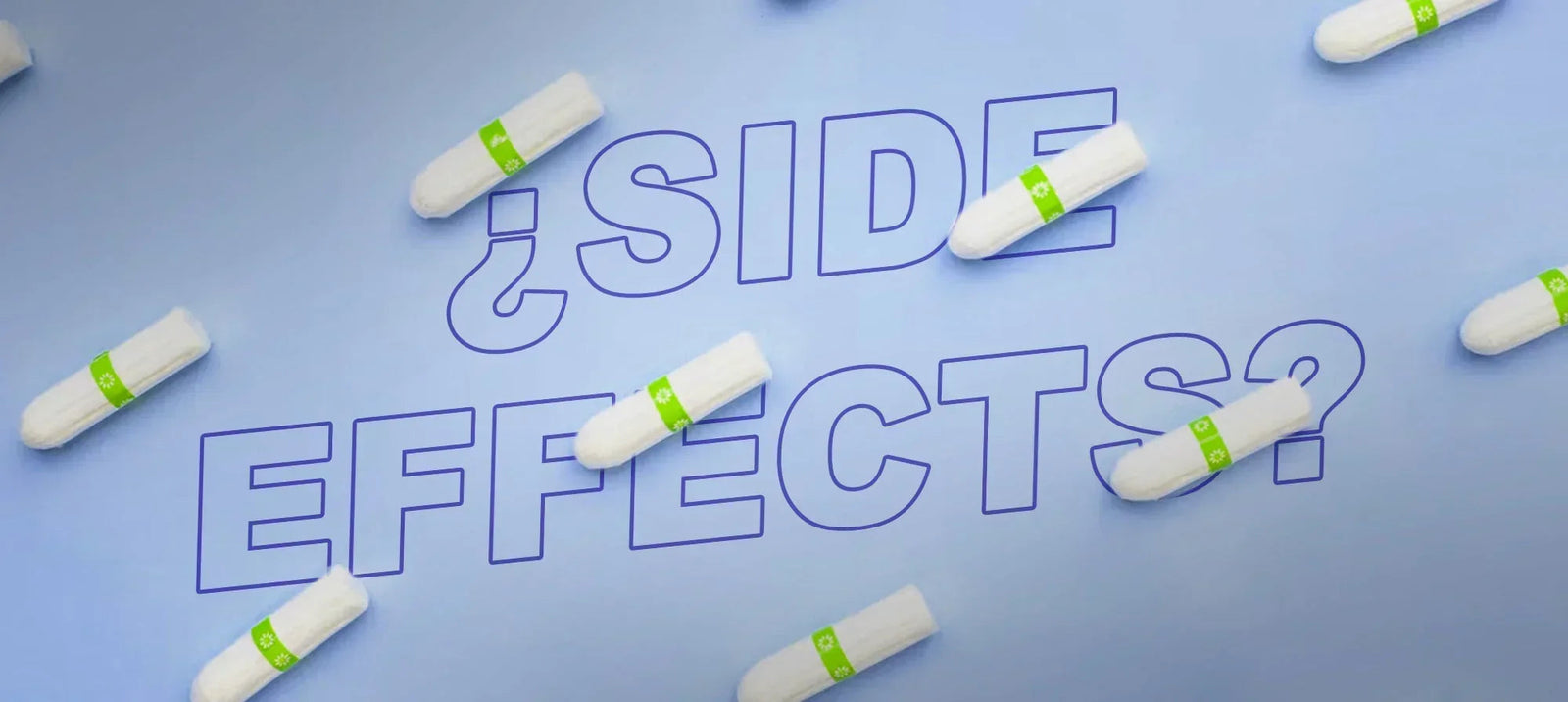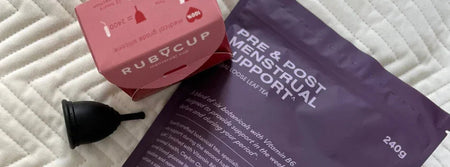At Ruby Cup, we are happy that people with periods around the world are starting to ask about the side effects of tampons. While they score big points for keeping your period under wraps and preventing leaks, tampons also have some side effects to keep in mind. Keep reading to learn why using more than one type of period products may be the best way for you to keep your body and the planet safe.
This article is written by clinician Amy Harris. Read more about Amy Harris at the end of the article.
What is your tampon made of?
Many of us don’t know, but we should. We read food labels and cleaning product ingredient lists – why not the fine print on tampon boxes?
Well, the fine print may not be there to read. In the U.S., the Food and Drug Administration (FDA) regulates tampons as medical devices. Despite activists’ efforts back in 2017, there are still no state or federal laws requiring tampon manufacturers to list ingredients. What you will find listed most of the time are the two ingredients the FDA requires tampons sold in the U.S. to be made from: cotton, rayon, or a mixture of the two.
Rayon is made from wood pulp, and environmental laws enacted in the 1990’s require tampon manufacturers to use either elemental chlorine-free (ECF) bleaching without chlorine gas or totally chlorine-free (TCF) bleaching agents in the manufacturing process. This helps prevent the release of toxic dioxins into the environment and your body.
Cotton is the other main ingredient in tampons. Cotton is nearly always bleached (with non-chlorine bleach) to kill any bacteria and clean the cotton so it is safe for you to wear inside your vagina. Studies show that dioxin exposure levels from tampons are 13,000-240,000 times less than what we normally consume through our diets. But even at these very small levels, the life-long exposure and accumulation of small amounts of dioxins could pose a health risk.
Modern-day high-tech tampons may also contain a mix of plastics, pesticide residues, and chemical additives. For example, did you know that most tampon strings are glued in, not stitched? As noted above, tampon manufacturers are not required to list all of the possible ingredients in your tampons and we still do not know many of the long-term, multi-generational effects of the chemicals found in tampons.

Tampons threaten your vaginal ecosystem
An ecosystem is a healthy mixture of plants, animals, and the environment. Healthy vaginas are like mini-ecosystems. On its own your vagina is home to a happy mix of bacteria (called Lactobacillus), living at the right level of hormones and acidity (called pH), supported by your normal vaginal discharge and healthy vaginal tissue.
Both our planet’s ecosystems and your vaginal ecosystem (aka vaginal microbiome) are fragile. Just like a tornado, oil spill, or forest fire disrupts an ecosystem in nature, using tampons, especially super-sized or perfumed ones, can knock your vaginal microbiome all out of whack.
Several studies have shown that differences in the materials used or the design of tampons does not significantly change the mix of bacteria in a healthy vagina, unless you consistently use overly-absorbant or scented tampons.
But what about that awful feeling of trying to pull a dry tampon out of your vagina on a lighter-than-expected flow day? That can’t be good for you right? Researchers have not been able to show that using tampons causes chronic vaginal dryness. One survey of 1500 menstrual cup users did report that people experienced less vaginal dryness after switching to menstrual cups. Even though the study was done by a Ruby Cup competitor, we welcome this vote of confidence. We eagerly await further clinical trials to confirm that tampons cause more vaginal dryness than menstrual cups.

Tampons carry a small risk of toxic shock syndrome (TSS)
Toxic shock as a result of using tampons is extremely rare- out of 100,000 people who menstruate, only one person will get sick with TSS in a year’s time. There are things you can do to lower your very low risk of TSS even further – like using tampons less often, changing them frequently, and not using super-absorbancy tampons.
There is likely a lower risk of toxic shock syndrome when you use menstrual cups instead of tampons, although this has not been proven in clinical trials yet. The medical-grade silicone used for period cups like Ruby Cup is easily-cleaned and sterilized before and after your period - e.g. with the Ruby Cup sterilizer. While fear of Toxic Shock Syndrome is not a reason to swear off tampons completely, it is one potential side effect to take into consideration when deciding whether a period cup is right for you.
Steer clear of scented tampons
Scented tampons are bad for you. Your vagina, in addition to being a healthy ecosystem, is also entirely self-cleaning. It does not need any additional douching, soaps, or scents. Vaginas are not supposed to smell like mint, lavender, or any of the other scents for sale. What creates a scent or perfume? Toxic chemicals like phalates, acetyladehyde, or synthetic musk. And a loophole allows manufacturers to simply list “fragrance” on the ingredient list, without having to be more specific.
Another loophole prevents the FDA from requiring manufacturers to test fragranced feminine hygiene products for safety before they are sold to consumers. Even if the FDA is not testing for long term safety effects, women’s health providers know these chemicals change your vagina’s healthy pH or acidity and welcome yeast or bacterial vaginosis infections. It is possible to have allergic reactions to the chemicals in scented tampons. Who wants vaginal swelling, pain, or itching? Period cups made of hypo-allergenic, medical-grade silicone are a much safer and comfortable bet for period protection.
Side effects of tampon use on planet earth
Even if most of the chemicals we reviewed earlier may be present at low enough levels to not make the FDA worry about your health, they still threaten the Earth. By buying tampons, you are supporting the demand for environmentally-harmful, unsustainable, disposable menstrual products.
Every time you toss or flush a tampon, you release toxic environmental pollutants into landfills and Earth’s water supply. Consider the cumulative pollution effect if the average menstruating person uses an estimated 11,000 tampons in their lifetime.
Another side effect of tampon use not to be ignored is the mountains of plastic-infused period product waste sent to landfills every year. Experts estimate about 20 billion tampons get buried in U.S. landfills each year. Those plastic applicators, wrappers, and other non-organic parts of tampon waste can take 500-800 years to fully break down and can’t be recycled. Instead, they may be burned, especially in developing countries, releasing toxic fumes.
Every day we make countless decisions with consequences for the Earth. It can be tricky to decide between a tampon or a menstrual cup, but remember, it does not have to be all-or-nothing.

Using more than one type of period product can be good for your health, and the planet’s health
While giving up tampons altogether might be the healthiest thing for your vagina and the planet, you don’t have to go cold turkey on tampons. We get that you may like to wear tampons when playing sports (although there are better menstrual cups for sports). Or maybe you don’t want to have to deal with washing out your period cup in an airplane lavatory on a trip.
You can choose when to use tampons and when not to by adding an easy-to-use period cup, like Ruby Cup, to your menstrual product repertoire. Even using a menstrual cup for a couple of days each cycle will:
- Reduce the overall number of tampons you use
- Keep your vaginal microbiome healthier
- Cut back on any potential exposure to toxic chemicals in tampons
- Lower your monthly menstrual hygiene environmental footprint
- Help the planet stay healthier
- Reduce period poverty with Ruby Cup’s Buy One, Give One program
FAQ’s
Do disposable menstrual products have toxins?
Yes, disposable menstrual products may contain very low levels of chemicals which could be absorbed through your thin vaginal walls into your bloodstream.
Today’s production methods for tampons and pads involve many potentially-harmful chemicals, but tampons and pads sold in the U.S. do have to meet FDA safety guidelines. The FDA specifically states that tampons must be “free of 2,3,7,8- tetrachlorodibenzo-p-dioxin (TCDD)/2,3,7,8-tetrachlorofuran dioxin (TCDF) and any pesticide and herbicide residues.”
The labels on disposable menstrual products can be misleading. Even if tampons are made from 100 percent cotton, they can still have chemical residues. Nowadays you will see plenty of disposable menstrual product labels proudly telling you that they are made only from cotton, that they are organic, or that they contain no synthetics, pesticides, or “harmful toxins.” The evidence for these claims is questionable at best and not tested or confirmed by the FDA or any other regulatory body.
What toxic substances are found in tampons?
Tampons are made from a combination of cotton and rayon or all cotton. Tampons could contain residues of chemicals used to grow cotton or wood pulp used to make rayon. Chemical residues from the tampon manufacturing process can also potentially linger on that tampon you insert into your vagina. Some of these possible chemicals include:
- Dioxins (used to bleach cotton)
- Pesticides
- Plastics
- Dyes
- Petrochemicals
Some of the substances used in disposable menstrual product production are endocrine disrupters, meaning that at high levels they can interfere with your body’s normal hormones and increase your risk for diseases like cancer.
Are there side effects of using organic tampons?
Yes. There is no data from any clinical studies showing that organic tampons are any safer than non-organic tampons (mostly because the studies have yet to be done). Organic tampons can be labeled organic because the cotton and rayon inside of them were grown with pesticides labeled as organic. There are still plenty of chemicals used in organic pesticides. So, even if you use organic tampons, you are still potentially being exposed to chemicals and pesticides.
Also, just because they are organic does not mean you are safe from some of the other side effects of tampons. Organic tampons still can:
- carry a small risk of toxic shock syndrome if worn for too long
- cause vaginal irritation or dryness
- disrupt your vaginal microbiome
- threaten the Earth’s health.
What happens if you leave a tampon in too long?
Usually nothing, except you might leak if your tampon is over-saturated, or maybe some vaginal dryness or irritation. Women’s health experts and the FDA recommend changing your tampon every 4-6 hours and using the least-absorbent tampon you need. This helps reduce the chances that the tampon “dries you out” by absorbing your vagina’s naturally-lubricating fluids and reduces your risk of toxic shock syndrome. We love period cups because you can leave menstrual cups in your vagina for up to eight hours without worrying about infections or your vagina’s health.
What are the long-term side effects of using tampons?
Quick answer? We don’t know yet. Even though tampons have been widely used by women since the 1970’s, little is known about long term side effects. As with Johnson and Johnson’s talc baby powder and ovarian cancer, it may take generations of micro-dosing of tampons’ chemicals and much more consumer advocacy to call attention to health hazards of long term tampon use.
As our understanding of the vaginal microbiome expands (new clinical trials and genetic sequencing start every day), it is likely that we will learn more about the ways in which tampons could impact fertility, risk of sexually-transmitted infections, or cancer risk in the long term. While we don’t have all the answers, it makes sense that using tampons less often may help limit your risk for some potential long-term side effects.
Written by Amy Harris.
Amy Harris is a certified nurse-midwife with more than a decade of clinical experience in reproductive health clinics, hospitals, and private OB/GYN practices. Amy holds a Masters of Science in Maternal and Child Health from Harvard School of Public Health and completed her nursing and midwifery training at Yale School of Nursing and Boston University School of Public Health. Passionate about empowering women through health education, Amy puts her public health training to work as a dedicated women’s health writer.










